Insect and Mite Pests of Hemp
THIS WEBSITE IS A WORK IN PROGRESS
LINK TO: Management of Hemp Pests Webinar
Tuesday, September 26th. 10:00 am EDT
Mite and insect pests are going to be an issue in the production of Industrial Hemp in Florida fields, shade structures and greenhouses. Crops will turn over rapidly but so will many of the pests we have already detected as part of the University of Florida Pilot Program.
This site is not meant to replace what is the best resource for insects and mites that attack hemp (Colorado State Hemp Insect Website). This site is aimed at presenting information about Florida arthropod pests and their management.
Making recommendations on how to manage the pests we discuss in this website will be forthcoming. Because this is a new crop and we have very little Florida data on how to manage them it will take a while to determine what is both effective and safe for the crop. We will use the FDACS Florida Pesticide List to determine which products we will evaluate. As you will see, there are 4 pages of products approved for use on hemp in Florida. This list will change over time, but it is all we have at this point. We can't evaluate all the materials listed and thus we will limit what we evaluate to products we have funding to evaluate or products that meet other criteria set my each of us who are planning to conduct such research.
- Florida Pesticide List: https://www.fdacs.gov/content/download/91490/file/fdacs-guide-list-pesticide-products-for-use-on-hemp-2020.pdf
- Pesticide Brochure: https://www.fdacs.gov/content/download/91491/file/hemp-pesticides-brochure.pdf
- UF/IFAS Industrial Hemp Pilot Project: Hemp pests in Florida: MREC Hemp Pests Fact Sheet
- Arthropod and mollusk pests of hemp, Cannabis sativa (Rosales: Cannabaceae), and their indoor management plan in Florida. https://academic.oup.com/jipm/article/15/1/1/7499162
-
APHIDS
Aphids are small, pear-shaped insects that feed on plant tissue using piercing-sucking mouthparts. Because of their feeding methods, aphids may introduce viruses into their plant hosts. Infestations are typically evident on the undersides of leaves, but shed white skins may be seen on the tops of the leaves. Warped or stunted plant growth is another sign of infestation.
Aphids produce a sugary substance called honeydew as digestive waste, which attracts many other insect types and encourages sooty mold growth in humid conditions. In greenhouse conditions, all aphids are female and give birth to genetic clones through live birth. When colonies become too dense, winged offspring are produced and spread to other plants.
Many species of ant have evolved to farm aphids for their honeydew. This symbiotic relationship can be troublesome to growers, since the ants will fend off aphid natural enemies, such as ladybeetles.
Aphids have many natural enemies. Various ladybeetle species are especially voracious and eat aphids and aphid eggs at both larval and adult stages, such as Convergent, Pink Spotted, and Asian Multi-Colored Ladybeetles. The larvae of syrphid flies and lacewings also feed on aphids, though lacewings may feed on other beneficials along with the aphids.
Certain small, parasitoid wasp species may also be used to control aphid populations. “Parasitoid” refers to species whose larvae live and grow parasitically within their hosts, eventually killing them. In the case of aphids and wasps, the wasp larvae eventually kill their aphid hosts, turning them into brown or black “mummies.” When grown, the wasps chew a hole and emerge from the mummies.
There are several situations that make biological pest control preferable to traditional control methods. The primary issue with the production of hemp is the limited number of pesticides that are currently legal to use on this crop. In addition to the lack of pesticides, aphids can be difficult to reach with a pesticide; the pesticide may be difficult to use, dangerous, or prohibitively expensive. Chemical pest control methods fail completely when resistant strains of the pest emerge. At this point, other control methods, such as banker plants, must be used.
Cannabis Aphid (Phorodon cannabis)
The Cannabis aphid (Phorodon cannabis), has caused significant issues in Florida because it is a regulated pest. Cuttings from other states have arrived in Florida with this pest on them. Infested plant material has resulted in growers having their plants quarantined until the aphids were no longer detected.
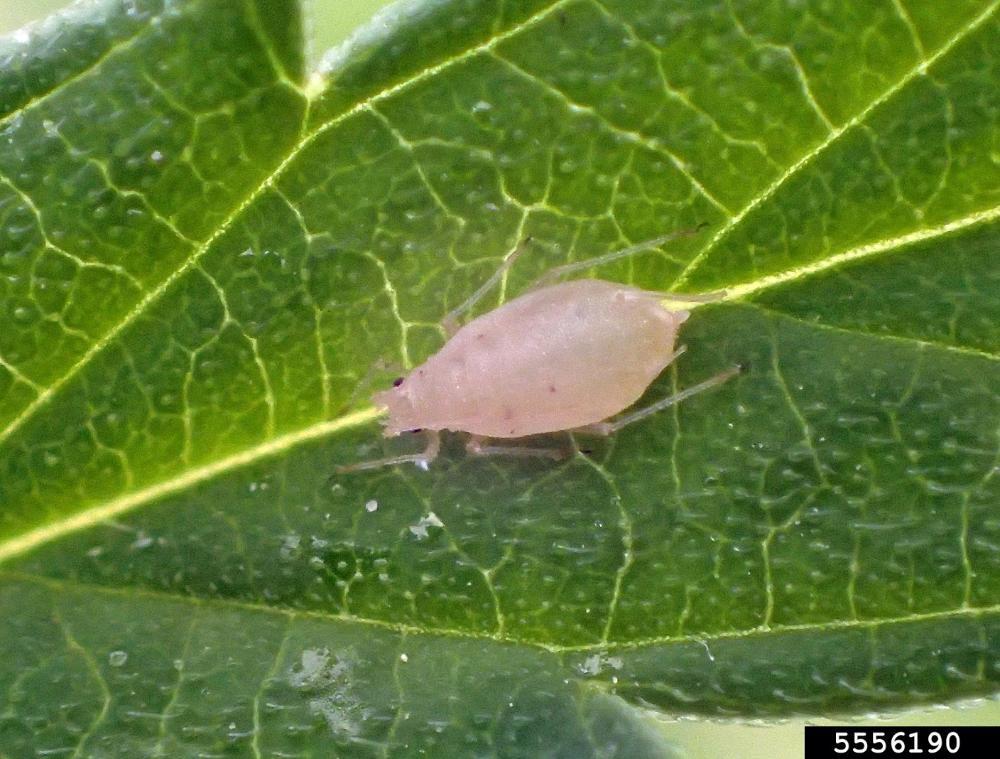
Whitney Cranshaw, Colorado State University, Bugwood.org
CANNABIS APHIDS ARE A REGULATED PEST IN FLORIDA. DETECTION CAN RESULT IN YOUR OPERATION BEING QUARANTINED!
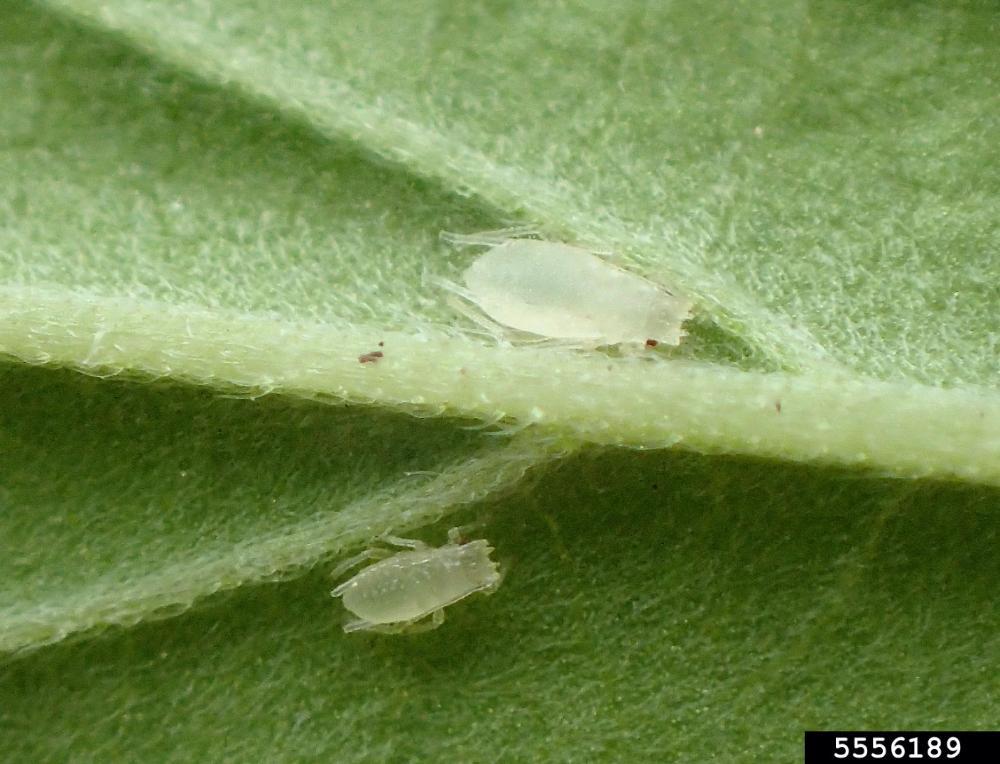
Whitney Cranshaw, Colorado State University, Bugwood.org
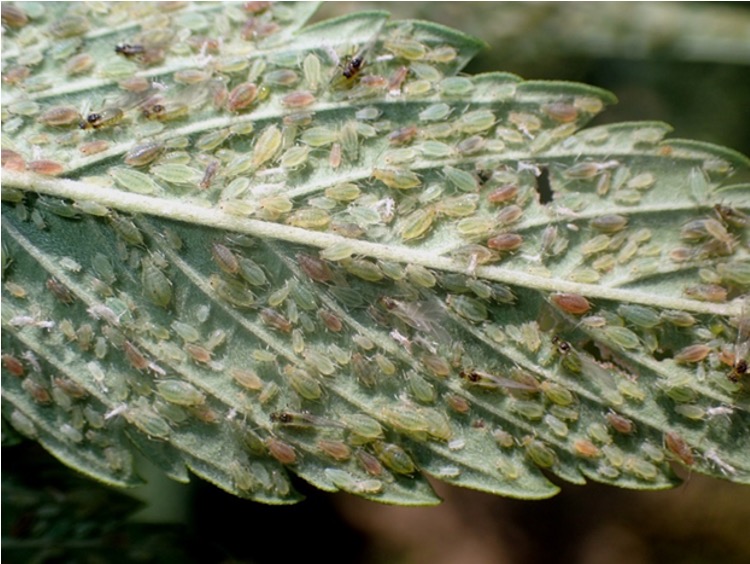
Whitney Cranshaw, Colorado State University, Bugwood.org
For more information on this pest visit: Cannabis Aphid by Dr. Whitney Cranshaw, Colorado State University
Rice Root Aphid
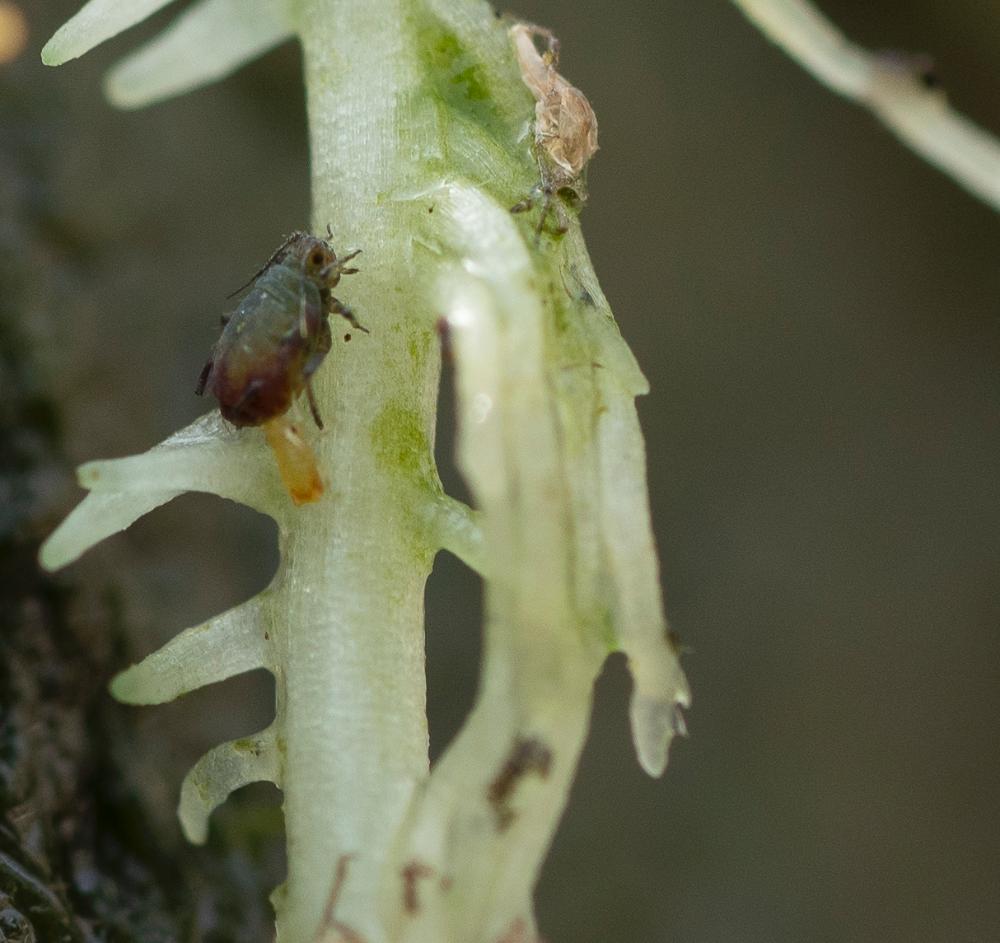
This is the rice root aphid which is a common pest on greenhouse grown hemp. The aphid feeds on the root system but will attack the upper portions of the plant when the pest density is high. In the photo there is a immature aphid that the adult has just given birth to. Note that the adult and immature have a red coloration around the back portion of the body.
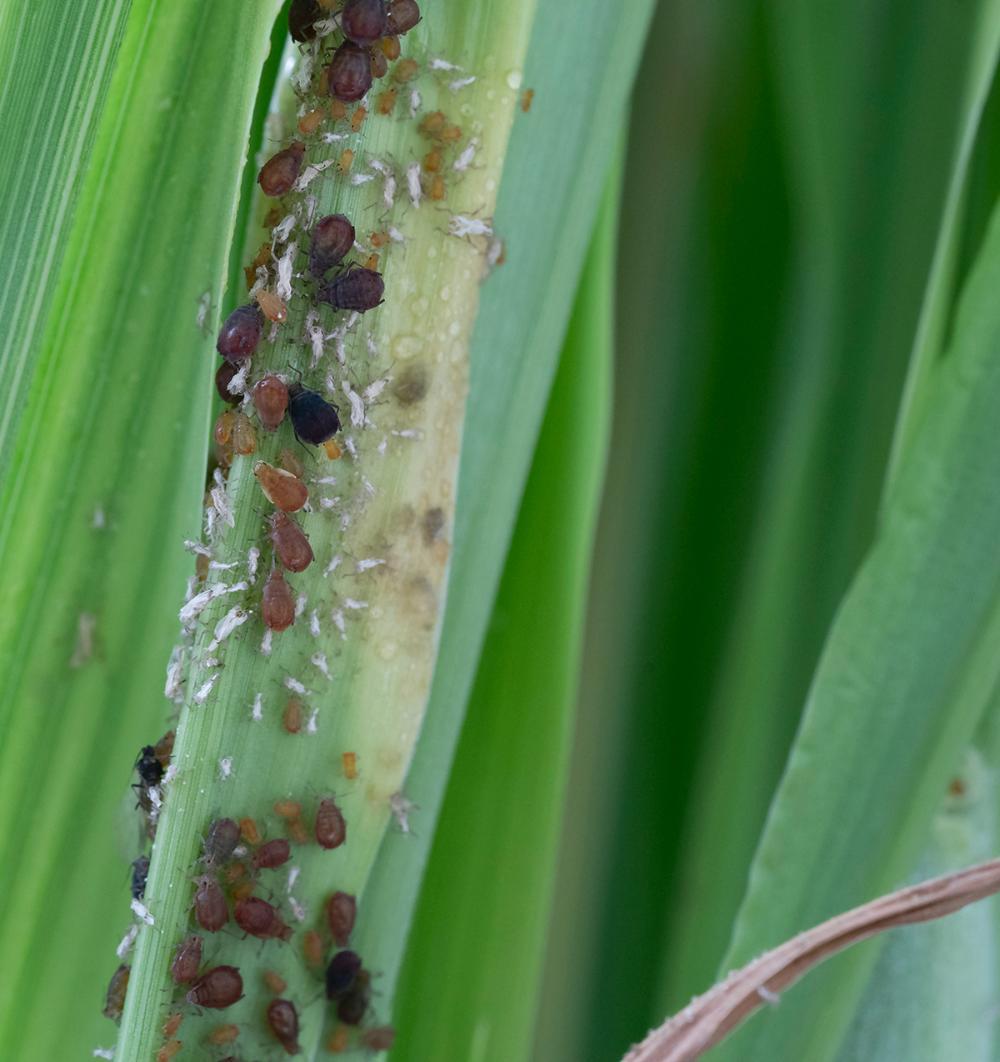
Colony of rice root aphid on the stems of sorghum.
MELON APHID
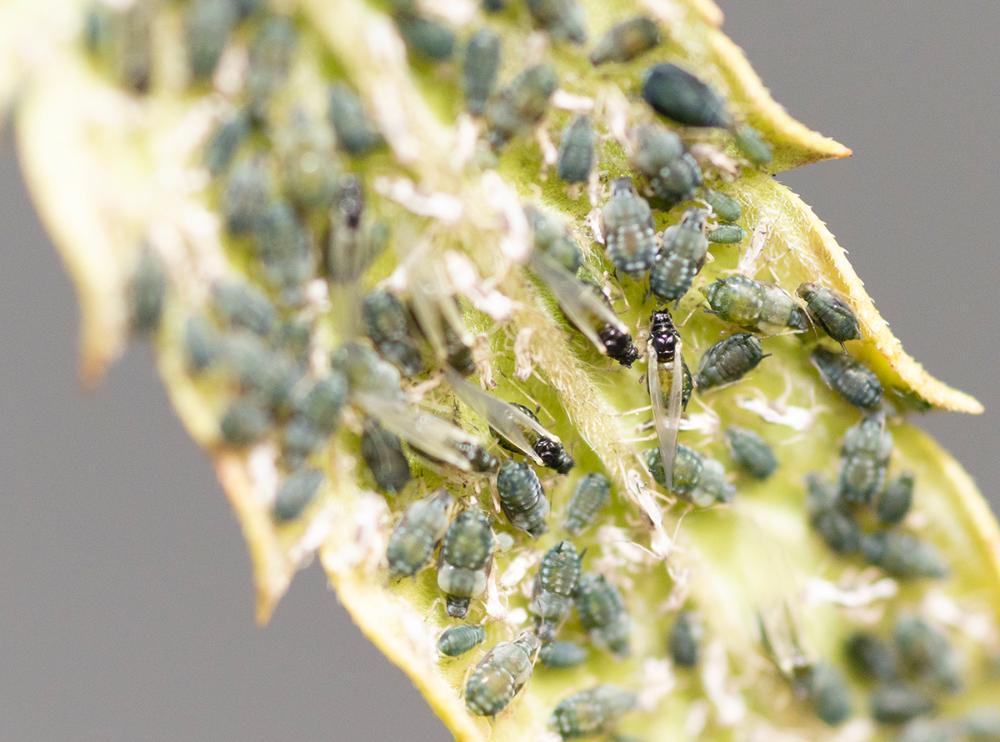
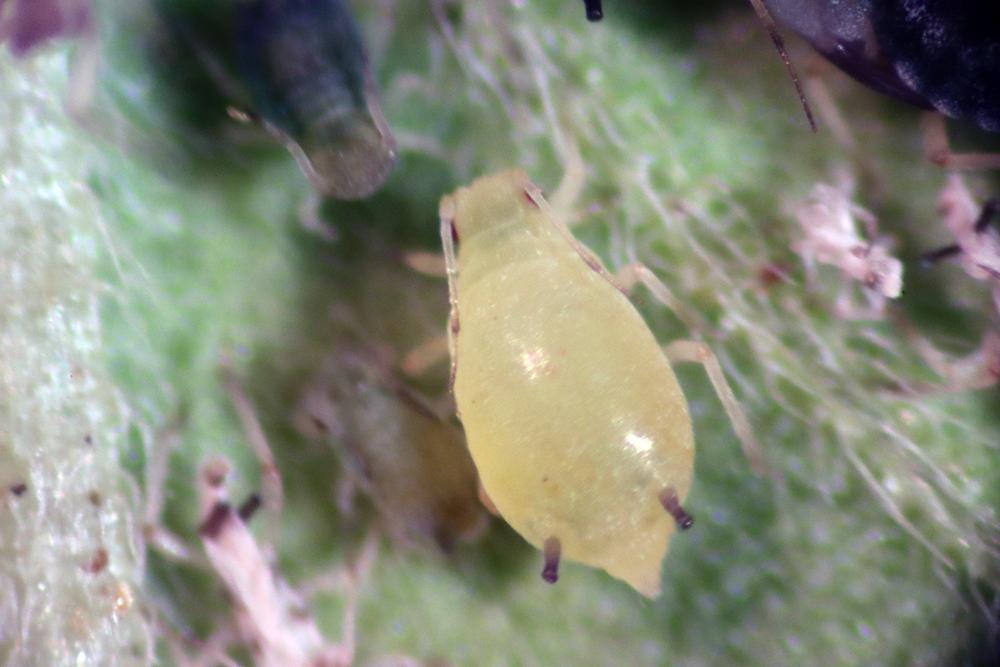
This light colored aphid is the same species of aphid shown in the previous slide. Aphis gossypii Glover is also called the melon or cotton aphid. This is the most common aphid encountered in Florida greenhouses. They vary from dark green to olive green to a tan or yellow color.
-
SPIDER MITES
MITES
NARRATED POWERPOINT VIDEO - MITE PESTS OF HEMP
There are three major groups of mites known to attack hemp plants in Florida. They are the spider mites, the tarsonemid mites, and the eriophyid mites. Mites are not insects, but more closely related to spiders and ticks. After hatching from the egg, the first immature stage (larva) has three pairs of legs. The following nymphal stages and the adult has four pairs of legs except for the Eriophyidae. The Eriophyid mite attacking hemp is the hemp russet mite and it exhibit great modification of body structure. They have only two pairs of legs; the four rear legs are absent. They are microscopic, elongate, spindle-shaped and translucent, and the abdomen usually has transverse rings present. Adult spider mites are the largest of the three groups being 1 mm in length or three times the size of a grain of salt (0.3mm). Broad mites are approximately half the size of grain or 0.15mm long and hemp russet mite is about 0.1mm. All these mites are difficult to see without a microscope or good quality 10-20x hand lens and a trained eye. If damage symptoms indicate a possible infestation, take the affected plant parts to your county extension office.
Spider mites are the most common mites attacking plants. The tarsonemid mites, such as broad and cyclamen mites, are common but not as common as the spider mites. Eriophyid mites are less common but are experiencing a significant increase in grower complaints about damaging levels.
Important Species. The most common spider mites found in Florida infesting ornamental plants are the twospotted spider mite (Tetranychus urticae) and Glover mite (Tetranychus gloveri). The most common tarsonemid mite is broad mite (Polyphagotarsonemus latus). There is only species of eriophyid mite currently a problem in hemp production. It is called the hemp russet mite (Aculops cannibicola).
SPIDER MITES
Feeding Damage and Symptoms
When twospotted spider mites remove the sap, the mesophyll tissue collapses, and a small chlorotic spot forms at each feeding site. An estimated 18 to 22 cells are destroyed per minute. Continued feeding causes a stippled, bleached effect and later, the leaves turn yellow, gray or bronze. Complete defoliation may occur if the mites are not controlled.
TWOSPOTTED SPIDER MITE
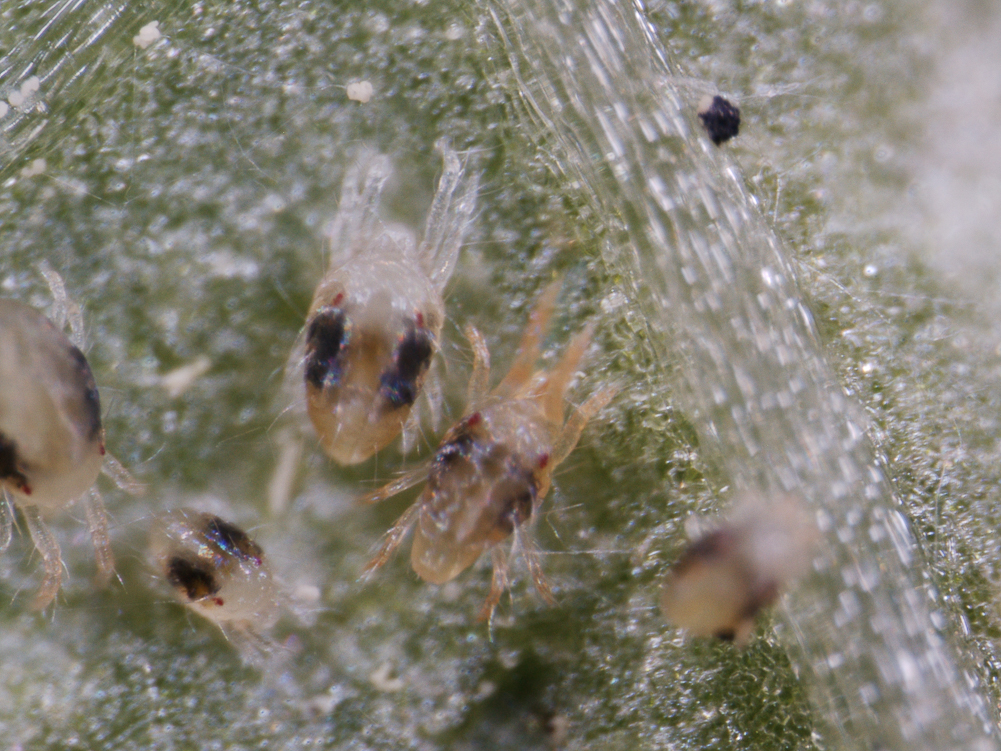
A group of twospotted spider mites.
The two spotted spider mite (TSSM) is a very common pest of greenhouse crops and is found throughout the United States. This pest has often been referred to as 'a red-spider' which refers to a stage in the life cycle when it goes into diapause. This seldom occurs in Florida. The TSSM is soft bodied, oval-shaped, the back arched and bearing bristles, measuring about 0.3 to 1 mm. in length and has two dark spots (sometimes four), one on either side of thetop.
The color can vary from greenish or yellowish, pearly amber depending upon the host plant and environment. Developmental rate is significantly determined by temperature. The developmental threshold, or the temperature above which development begins, is approximately 51.6 °F (10.9 °C). The number of degree days needed to develop from egg to egg (1 generation) is approximately 265.3 above 51.6 °F (147.4 above 10.9 °C). Under greenhouse conditions, the average development time from egg to adult is 14-21 days. However, mites develop quickly under hot, dry conditions and may mature in as few as 7 days during these periods. It has been estimated that in a month’s time one female and her progeny are capable of producing: 20 mites at 60 °F, 13,000 mites at 70 °F, and well over 13 million mites at 80 °F average temperature. Thus, it is easy to understand why mites can be such a problem in the hot days of summer.
Eggs are laid singly on the surface of leaves. The eggs are spherical and found on the underside of the leaf often where mite feeding is noticeable. The color of eggs varies from transparent to opaque straw yellow. The immature is lighter in color than the adult, usually pale green or yellow. Young mites only have six legs. The older immature is slightly smaller than the adult and pale green to brownish green and has eight legs.
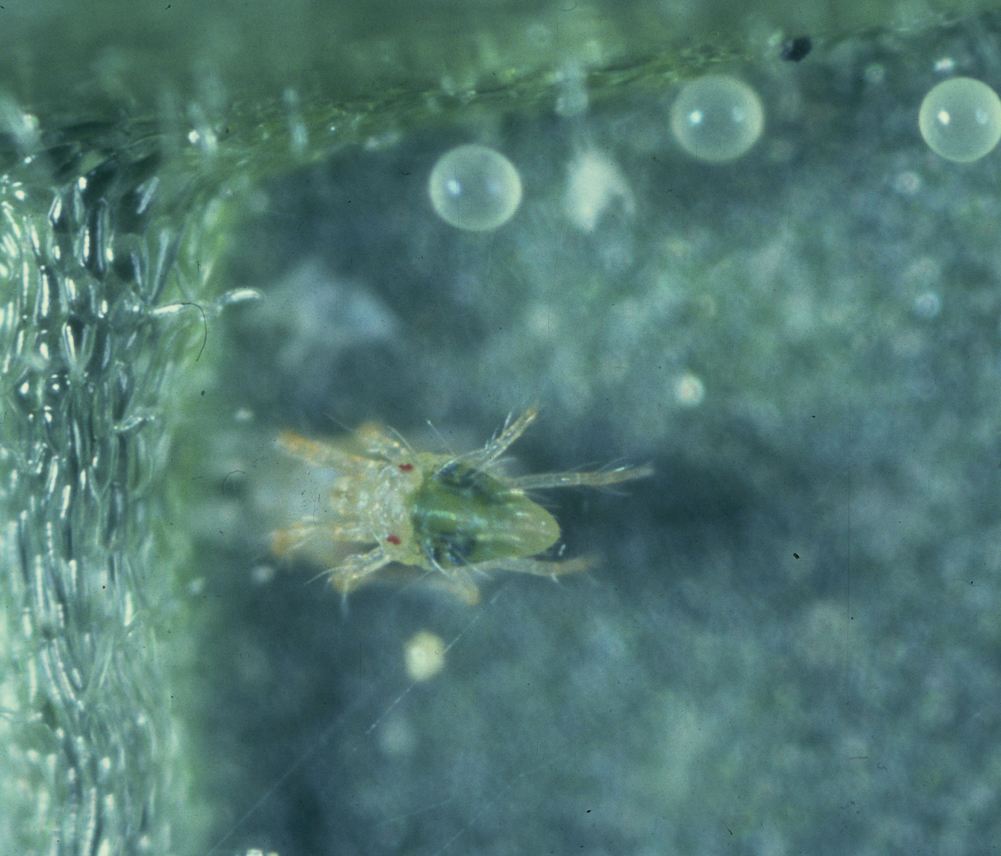
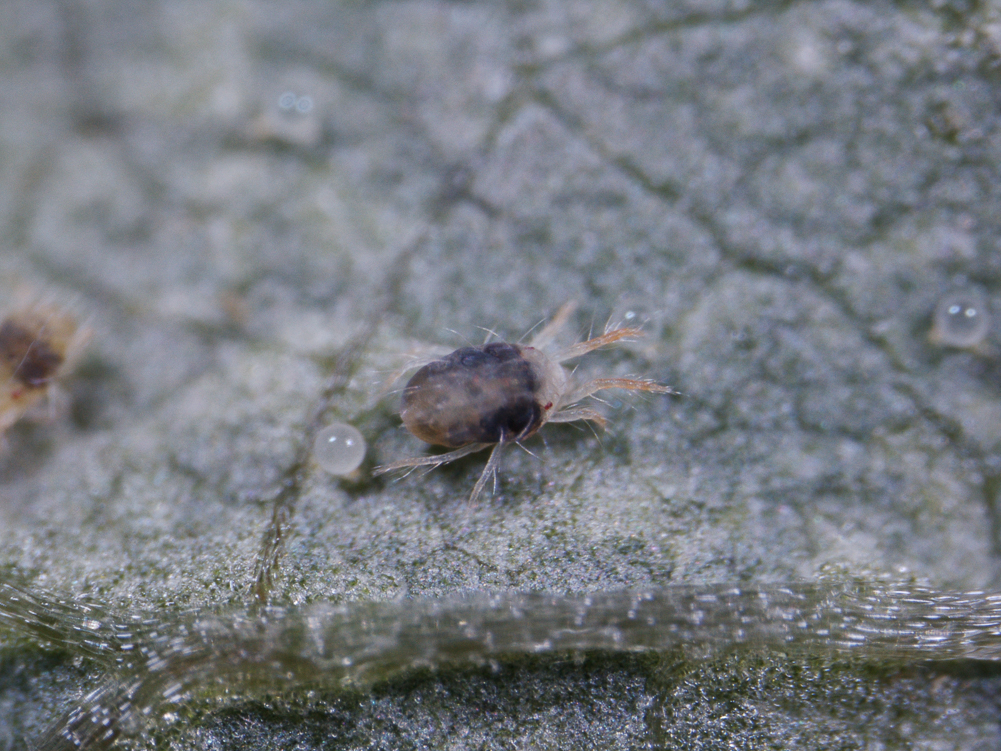
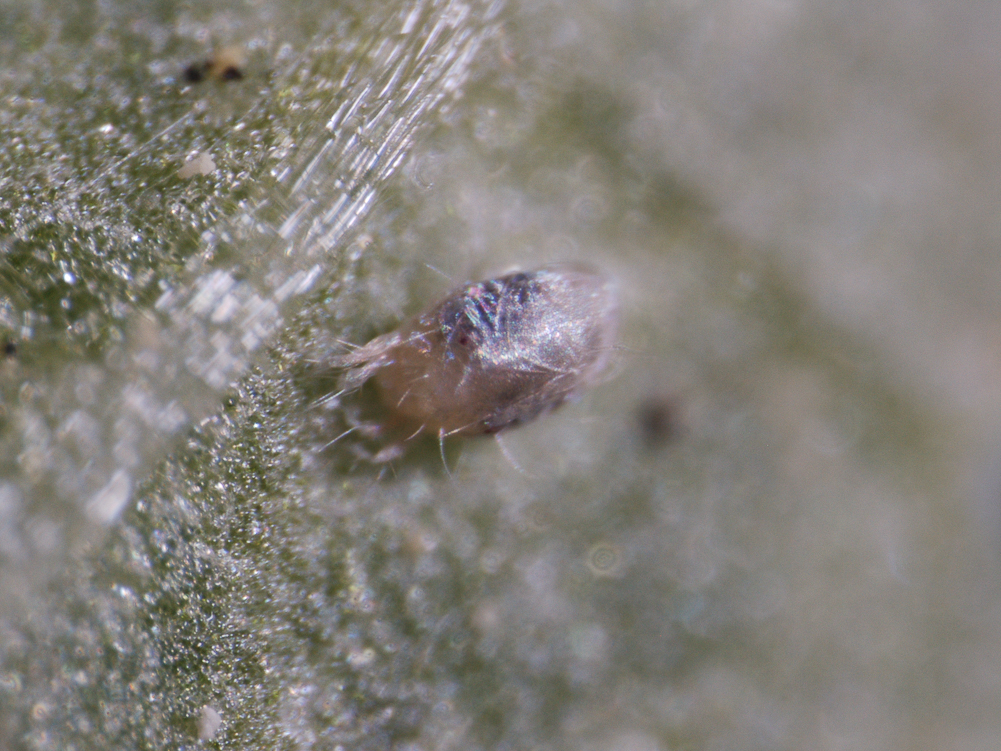
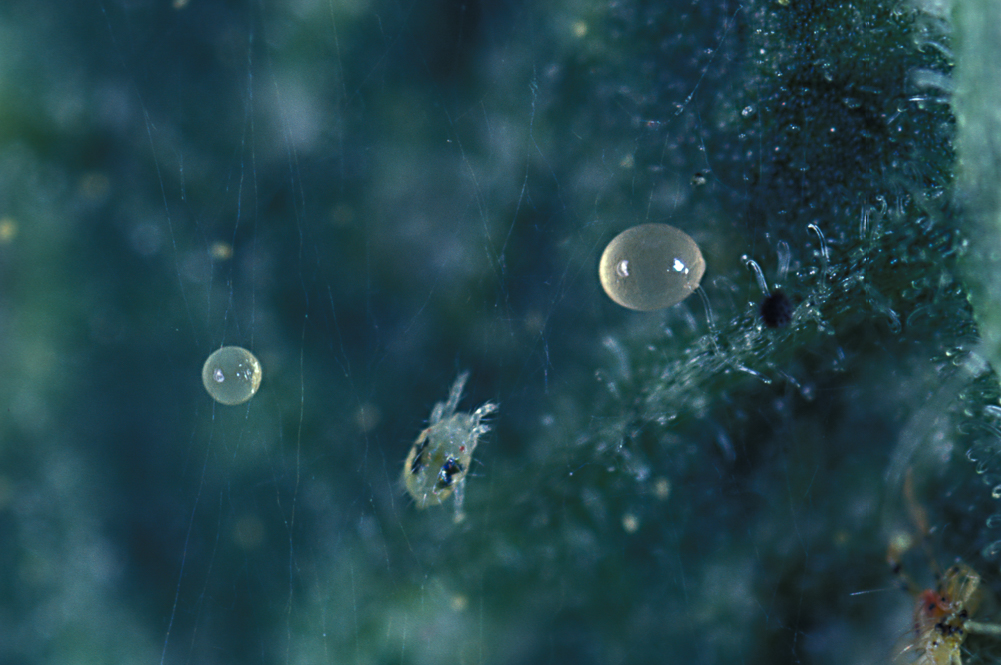
GLOVER MITE
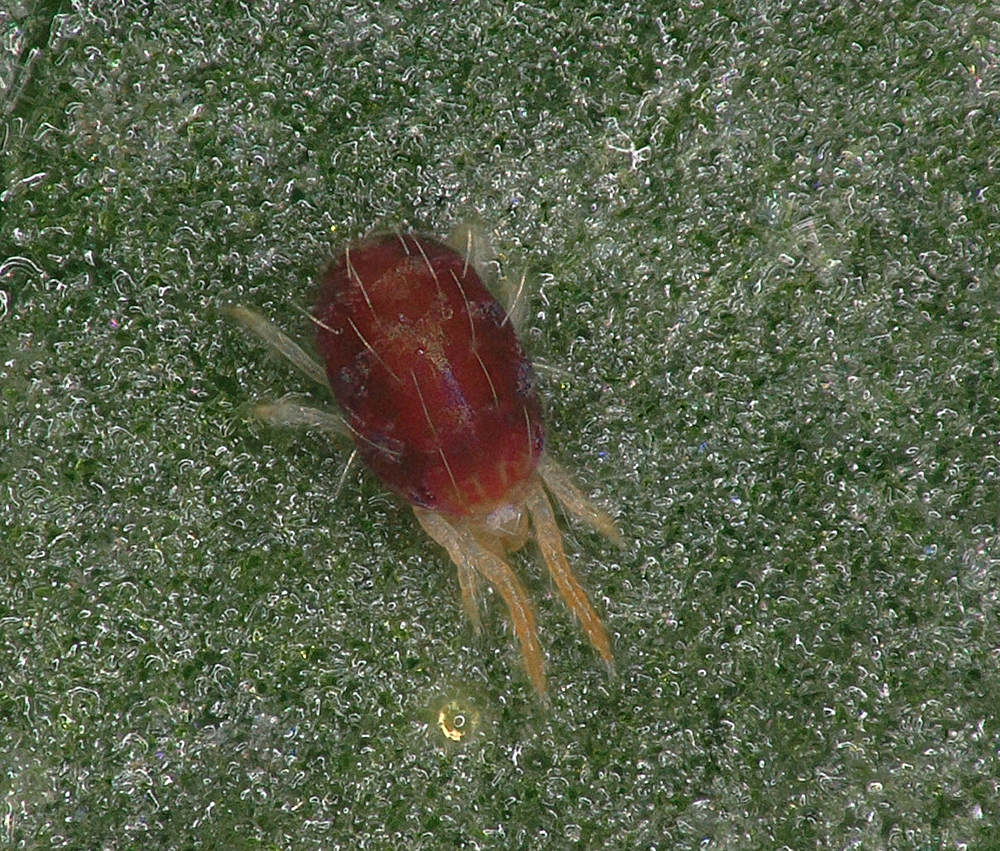
This mite has become a major pest in both the field and greenhouses at the UF/IFAS Mid-Florida Research and Education Center.
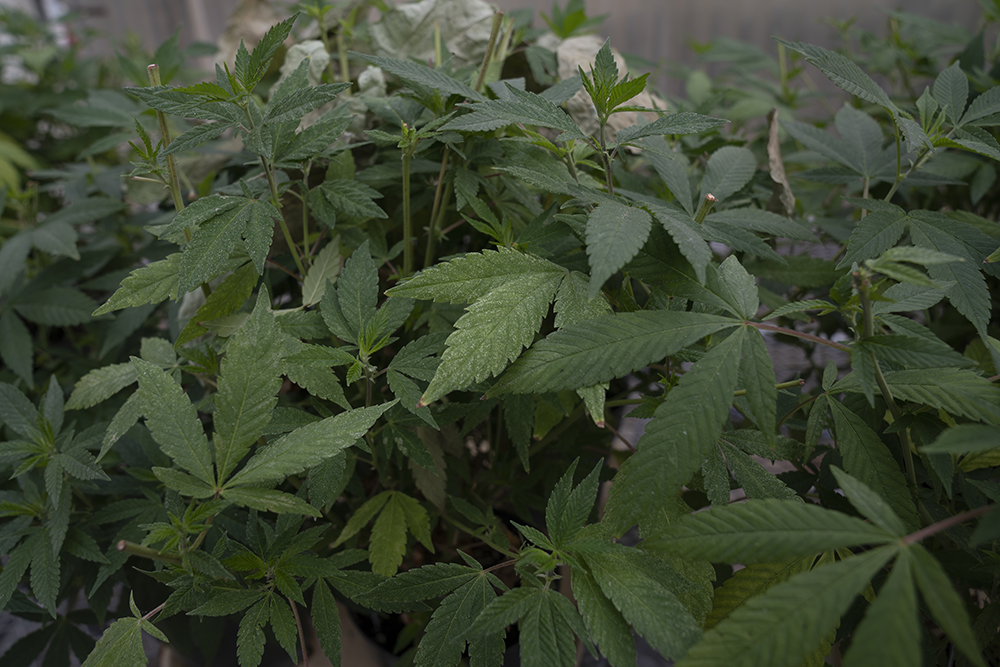
The damage caused by Glover mite looks a lot like that caused by twospotted spider mite. The mites feed on the contents of individual cells at the leaves become covered with yellow stippling over time.
-
RUSSET MITES AND BROAD MITES
RUSSET AND BROAD MITES
These very small mites pierce and suck the cell fluids of surface plant cells. At low populations symptoms are not very obvious, but large populations can cause slight upward curling of the leaf edges, a general dullness or russeting of the leaves, yellow or brown spotting on the leaves, and petiole brittleness. Developing flower buds may have reduced yield and quality with heavy infestations. Magnification of 15-20x is required to see these mites. Broad mite eggs looked like they are spotted.
Control with horticultural oils and some predatory mites.
RUSSET MITES (Aculops cannibicola)
Russet mites are a regulated pest in Florida.
Detection can result in your operation being quarantined!NARRATED POWERPOINT VIDEO- MITES PESTS OF HEMP
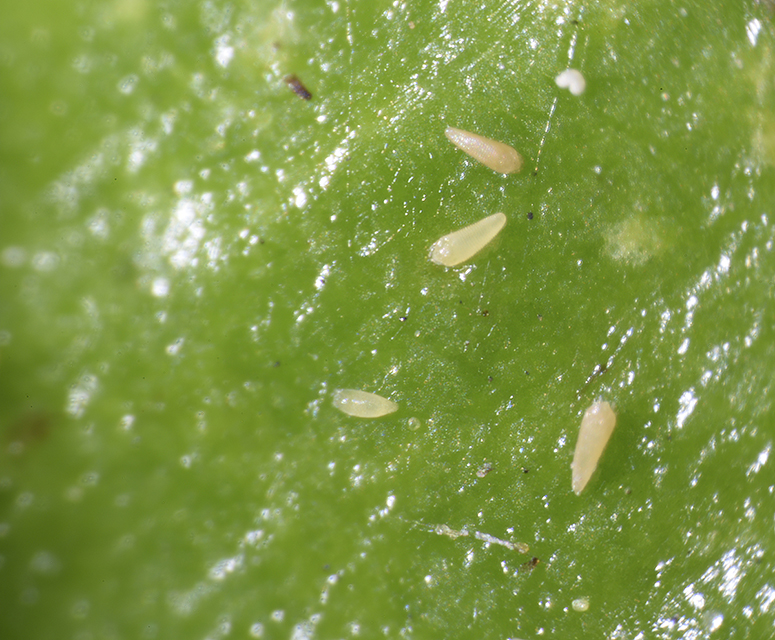
BROAD MITES
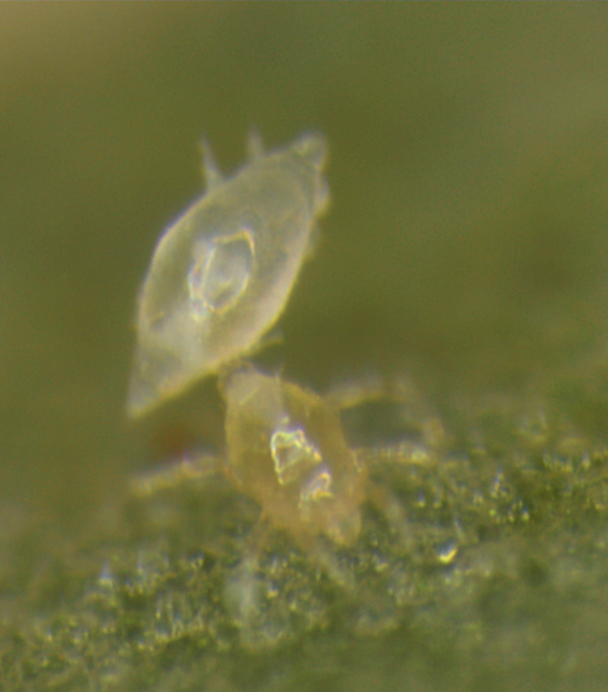
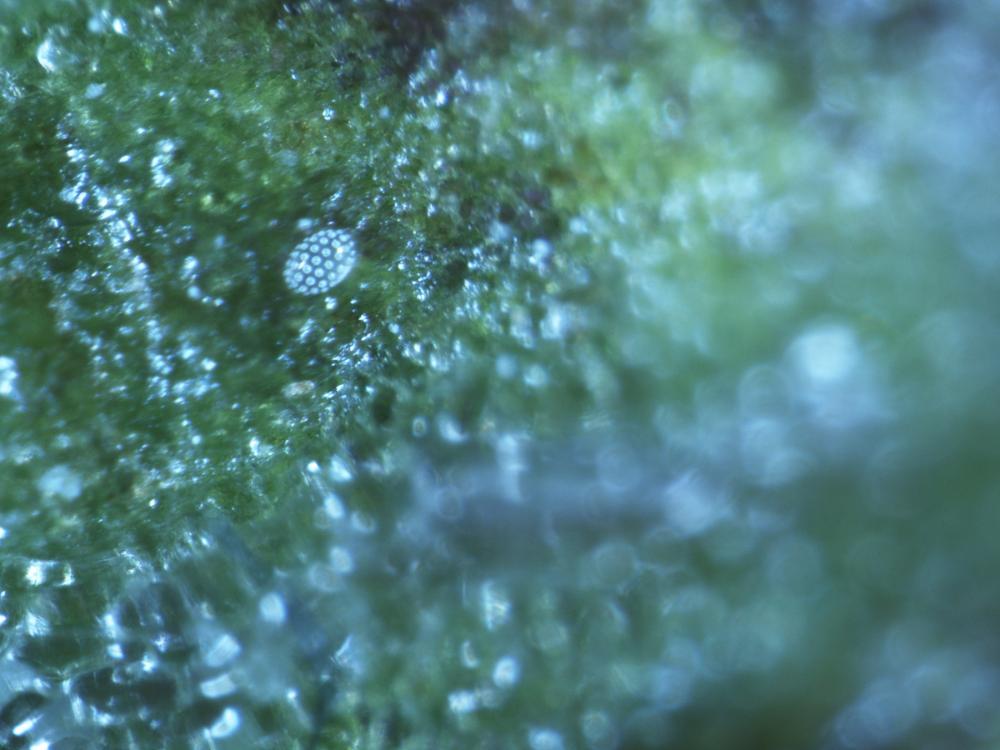
-
CATERPILLARS
CATERPILLARS
There are several types of caterpillars that eat hemp – Tobacco budworm, Corn earworm, and Omnivorous leaf roller are most commonly seen. The corn earworm is one of the worst pests of hemp in the field. Biorationals like Bacillus thuringiensis provide the best control for caterpillars.
The larval stages of the leaf roller feed on leaves and flowers. The larvae will roll the leaves or buds into a tight mass forming a “nest” around itself as it feeds. Eventually it will pupate within this nest.
Tobacco Budworm - Heliothis virescens
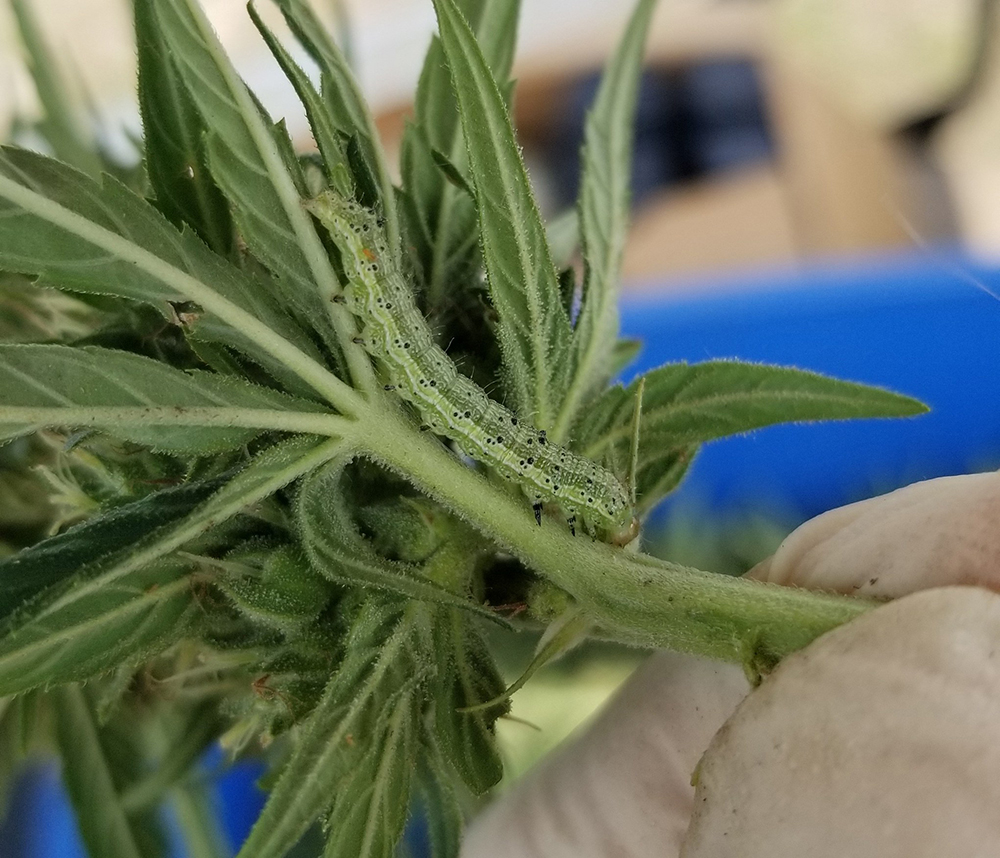
Photo by Dr. Steven Anderson. This caterpillar was attacking hemp planted in an experimental planting of hemp in Apopka, Florida. It was identified as the tobacco budworm, Heliothis virescens (Fabricius). There was a building population in late April to early May when the experiment was terminated.
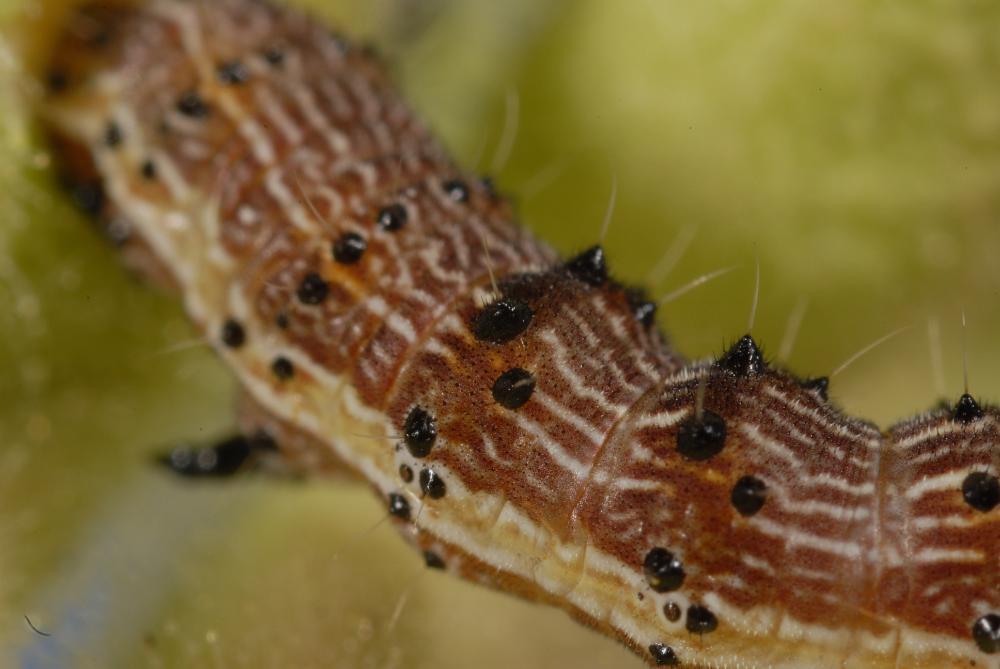
Photo by Lyle J. Buss, Entomology & Nematology Dept., University of Florida
The microspines on the tubercles of the Tobacco budworm and Corn earworm larvae are used as a characteristic to determine which species you are looking at. The microspines on Tobacco budworm are larger and cover most of the tubericle.
For more information on this pest visit: Tobacco budworm.
Corn Earworm - Helicoverpa zea
Photo by Lyle J. Buss, Entomology & Nematology Dept., University of Florida.
Photo by Lyle J. Buss, Entomology & Nematology Dept., University of Florida
This caterpillar is one of the worst pests of hemp grown in the field around the country. For more information on this pest visit: Helicoverpa zea
Omnivorous leaf roller - Platynota stultana Wlshm.
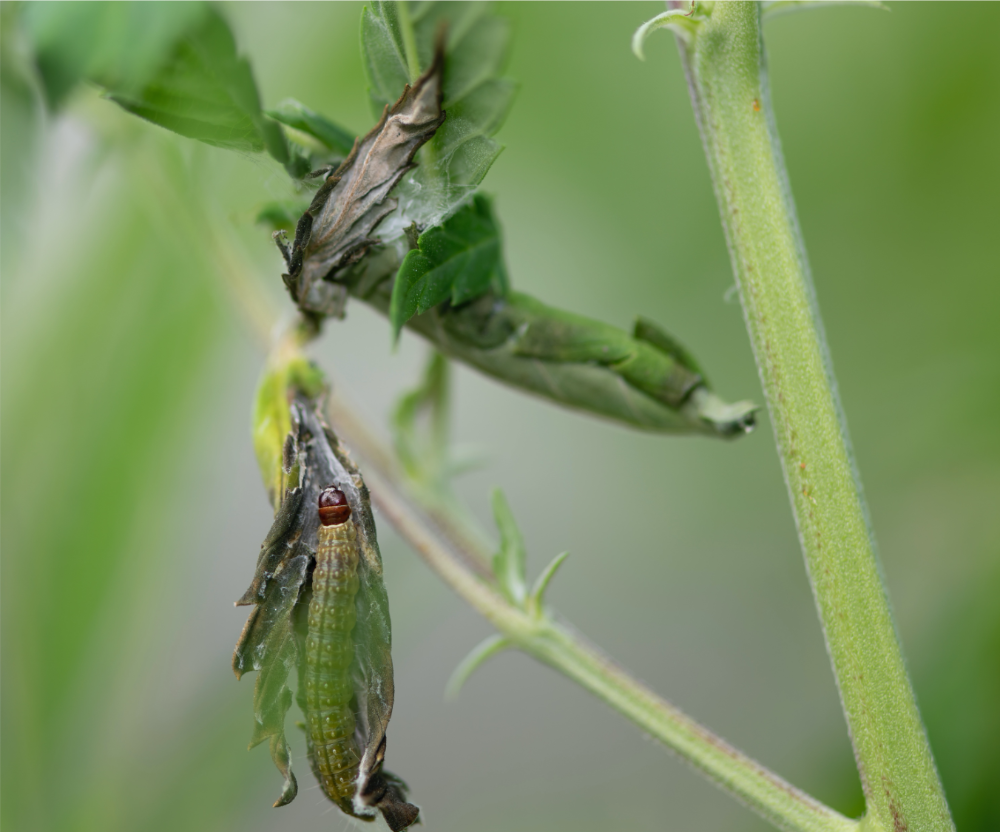
The omnivorous leaf roller, Platynota stultana Wlshm. can become a major pest of plants grown in the greenhouse.
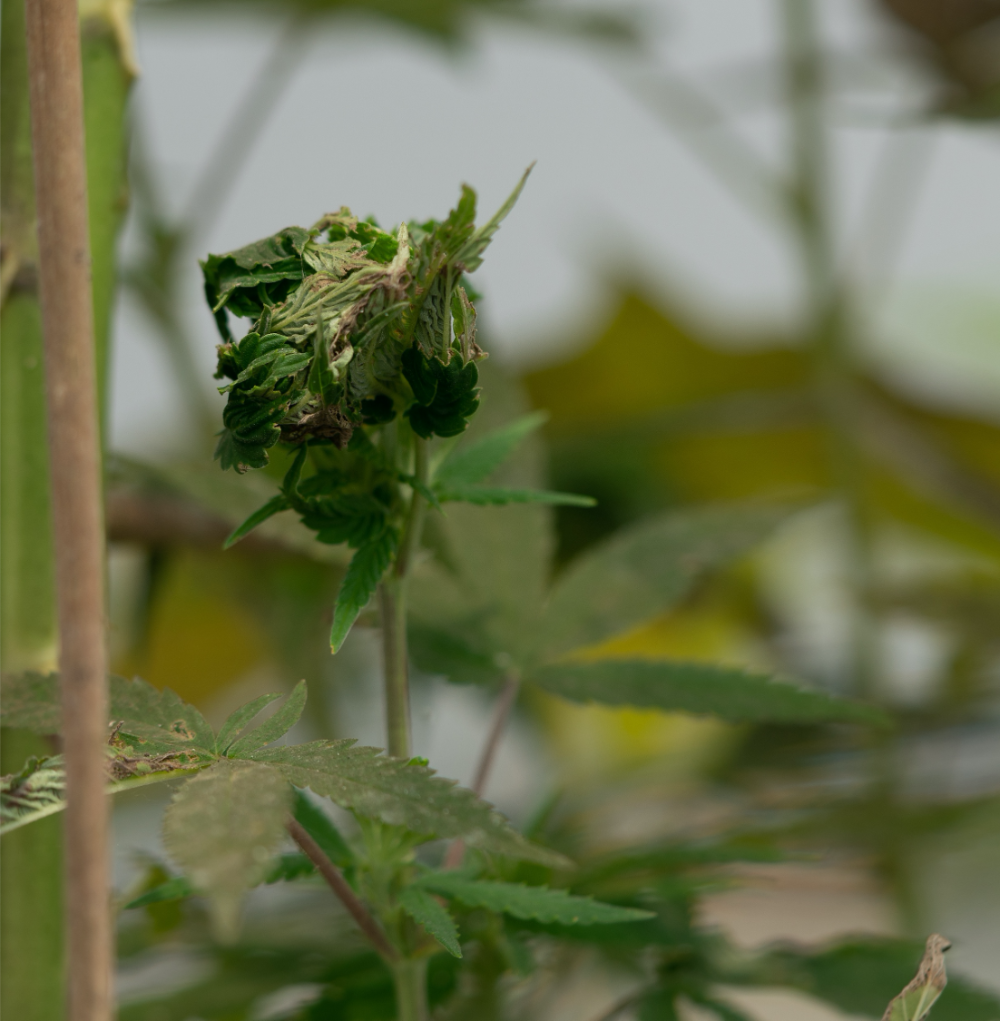
The larval stages feed on leaves and flowers. A larva will roll the leaves or buds into a tight mass forming a "nest" around itself as it feeds. Eventually it will pupate within this nest.
This caterpillar has invaded multiple greenhouses at the Mid-Florida Research and Education Center in Apopka.
ADDITIONAL RESOURCES
A video by Aurora Toennisson (A former student of Dr. Hannah Burrack, NCSU): Distinguishing tobacco budworms from corn earworms.
An infographic by Jonathan Larson and Katelyn Kesheimer created to help people ID and look for CEW in hemp. CEW in Hemp
-
THRIPS
THRIPS
Thrips are small, narrow-bodied insects with feathery wings and piercing-sucking mouthparts. Various thrips may attack hemp. Blooms attacked may be deformed or fail to open, while leaves may be silver-flecked or bronzed in appearance or scarred, deformed and curled. Some species may also spread viruses.
Control with horticultural soaps, predatory thrips like Franklinothrips vespiformis, green lacewings, minute pirate bugs, and predatory mites like Amblyseius swirskii.
Echinothrips americanus
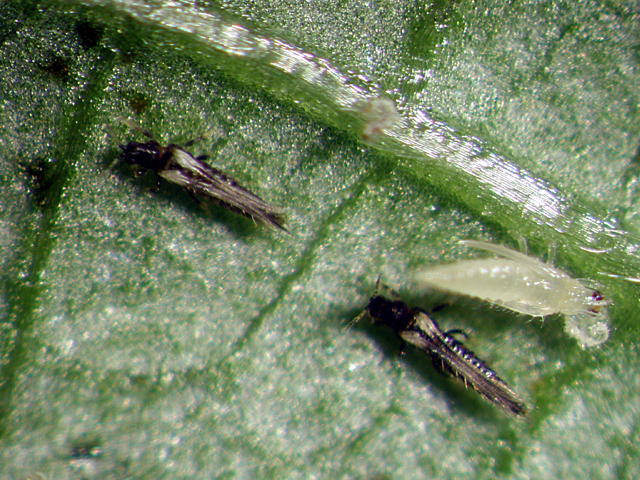
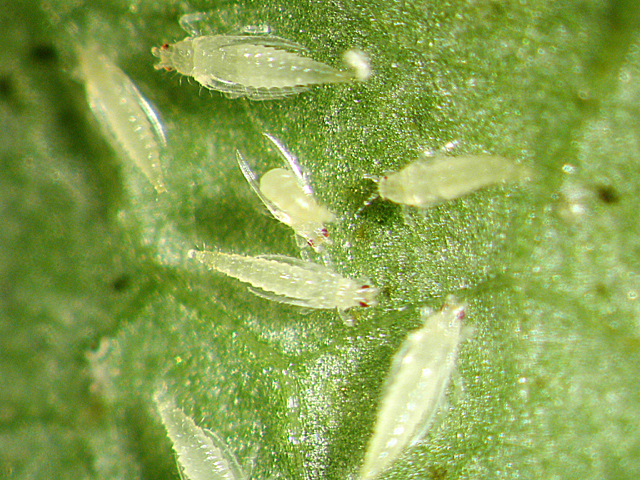
Franklinothrips vespiformis Crawford is a generalist predator but it appears to be very effective at managing this particular thrips.
For more information see: Franklinothrips vespiformis Crawford
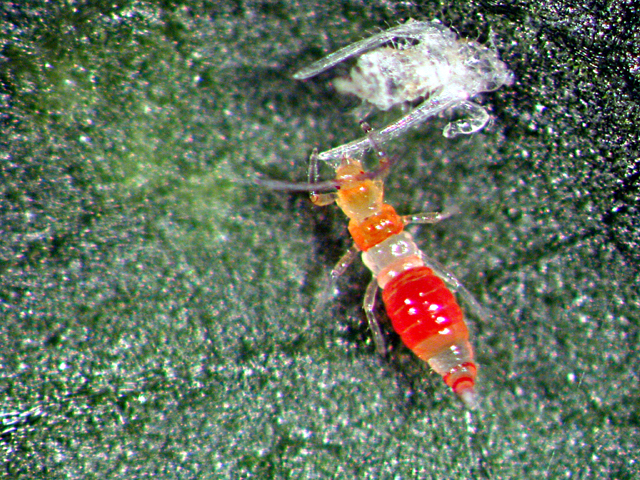
Franklinothrips vespiformis Crawford is a generalist predator but it appears to be very effective at managing this particular thrips.
For more information see: Franklinothrips vespiformis Crawford
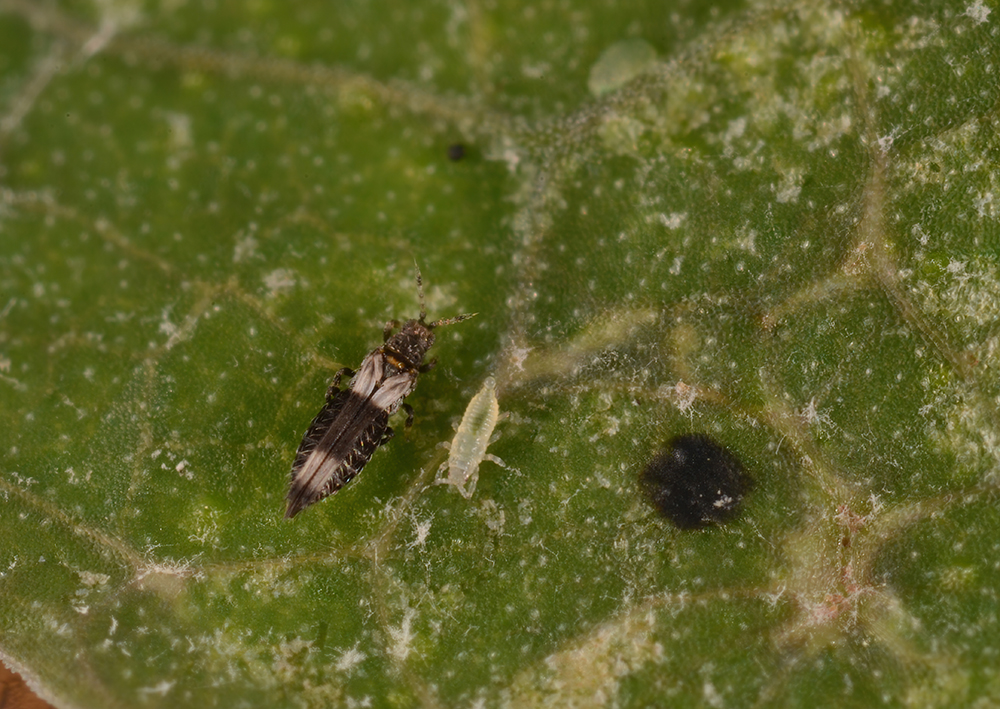
Caliothrips phaseoli on sweet potato.
Photo by Lyle J. Buss, Entomology & Nematology Dept., University of Florida
-
WHITEFLIES
WHITEFLY
Whitefly adults are moth-like, covered with a white, waxy powder. Eggs, laid on the underside of leaves, are light colored, turning to dark blue or purple before hatching. Newly hatched crawlers move about for a few hours and then insert their mouthparts and feed without moving. Larvae look like small greenish or yellowish scales. They suck plant juices only on leaves, usually on the underside, and excrete lots of honeydew. Their feeding causes stem blanching, yellow spots, leaf yellowing and shedding and possibly plant death. They also transmit many devastating viruses.
Biological controls include predators Orius, Delphastus, and lacewing larvae; parasitoids Eretmocerus and Encarsia; and insect pathogenic fungi.
Bemisia
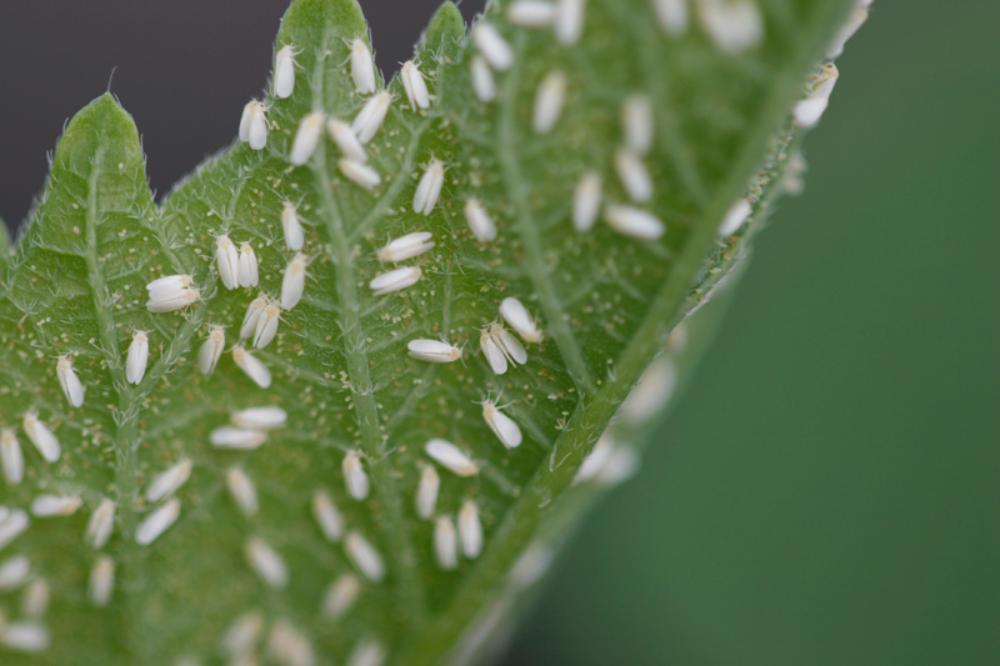
This photo shows the density of adults that can occur in the field. The plant is hibiscus and the adults are the MED or Q-biotype of Bemisia tabaci.
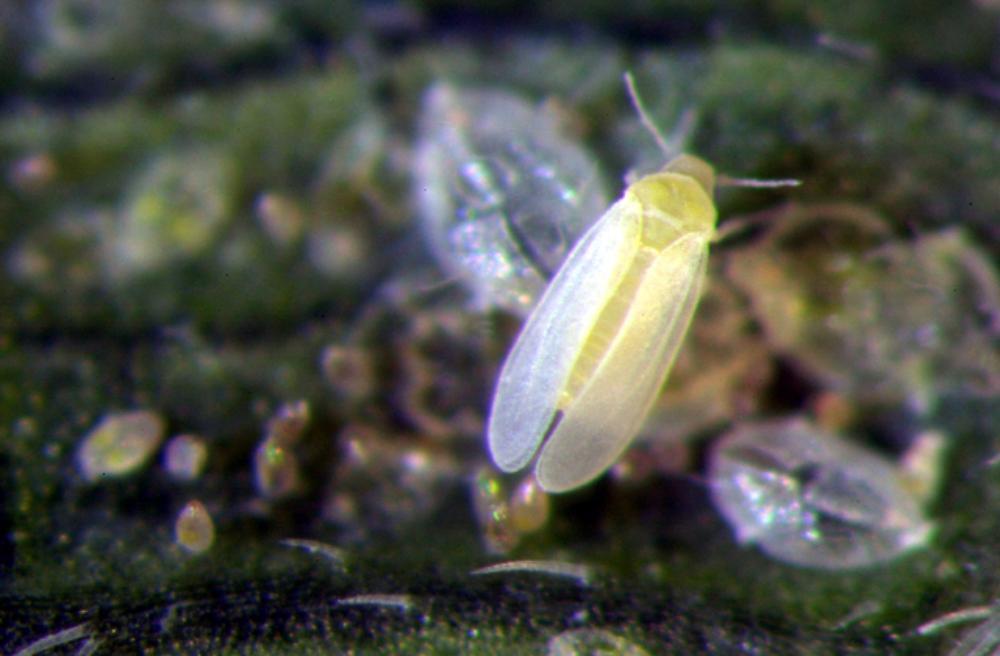
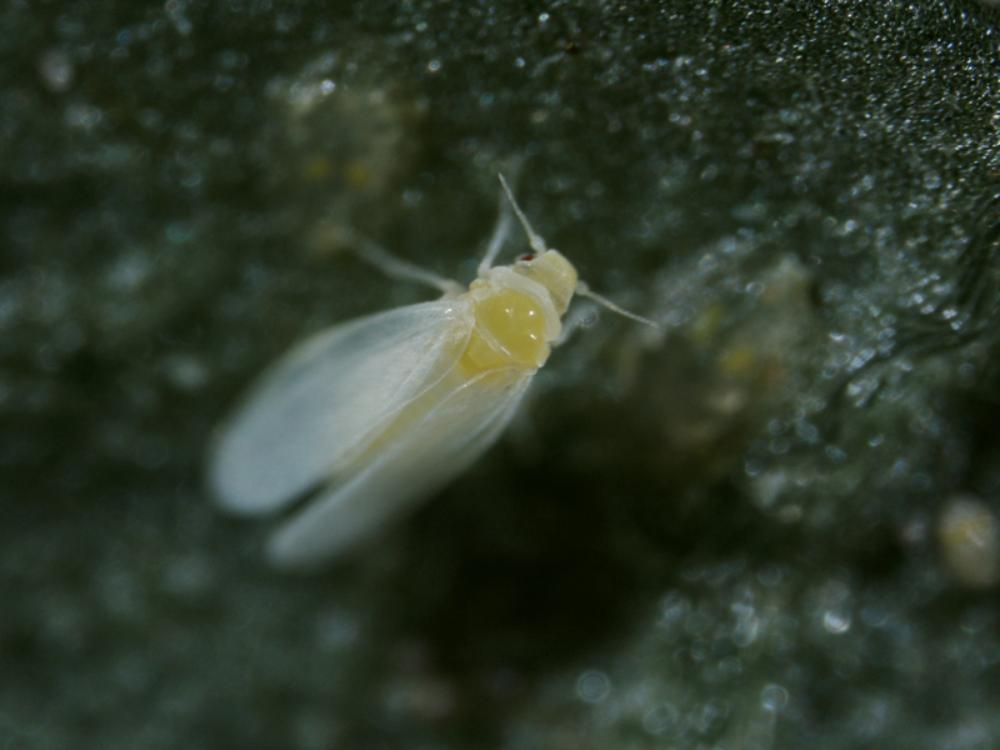
This is a photo of a whitefly just before in emerges from the last immature stage as an adult.
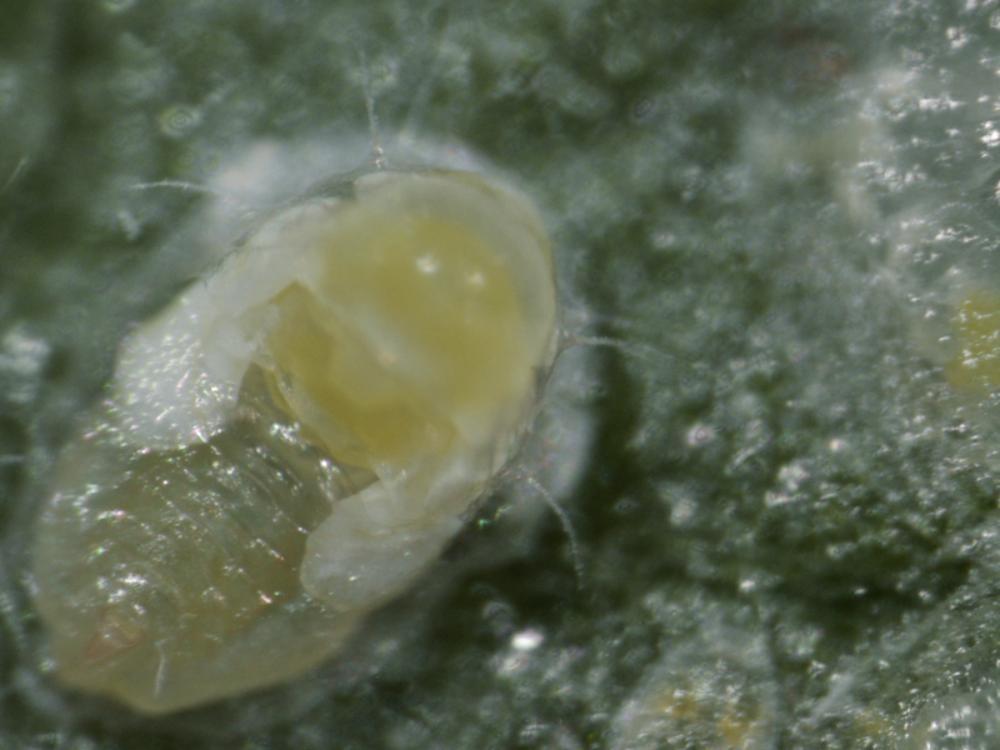
-
BEETLES
BEETLES
Diaprepes beetles lay eggs in a single layer in an irregularly shaped cluster on leaves that are folded and glued together. The white and legless larvae, which may eventually reach 1 inch in length, emerge, fall to the ground, and enter the soil to feed on the roots. They may girdle roots and provide an entry point for root rot organisms. Adults emerge to feed on the edges of the leaves, causing a characteristic scalloped notching. Adults are 3/8-3/4 inch long and may appear all black or orange/red with black stripes. Their primary emergence period is May through October and November in central Florida. Plastic mulch may help to reduce larvae reaching the roots.
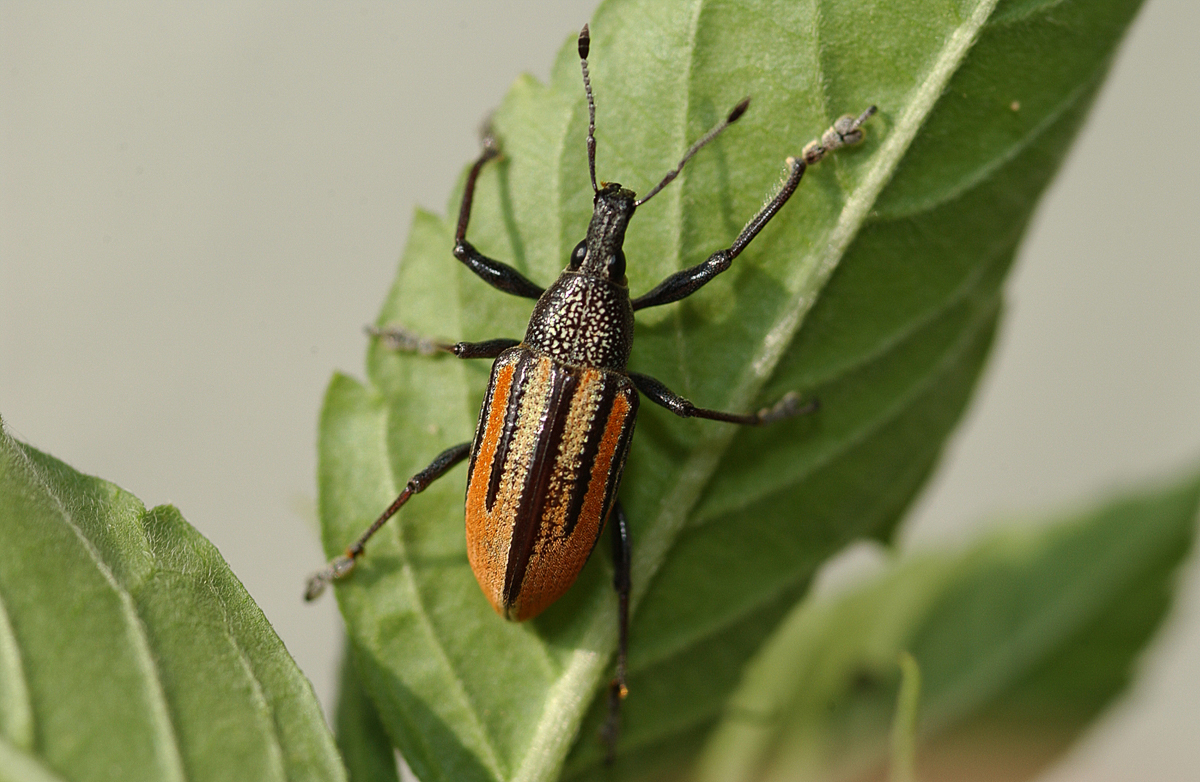
The beetle adult and larva above are Diaprepes abbreviatus (Linnaeus).
For more information, see UF/IFAS Featured Creatures: http://entnemdept.ufl.edu/creatures/citrus/diaprepes_root_weevil.htm
-
MEALYBUGS
MEALYBUGS
Mealybugs are soft-bodied insects with piercing-sucking mouthparts and a covering of fuzzy, white, waxy secretions. They excrete honeydew on which sooty mold grows. There are a variety of different mealybugs that may infest the leaves, roots or buds, and the combination of their waxy covering and hiding in plant crevices make good coverage with control sprays difficult. Young mealybugs hatch out from under the waxy coating and move to new sites, providing the best timing for chemical control.
Control is usually through horticultural oils or neem oil (good coverage required) or biological controls like ladybird beetles Cryptolaemus montrouzieri, and green and brown lacewings.
-
STINK BUGS
Stink Bugs
Stink bugs belong to the family Pentatomidae in the order of Hemiptera: the true bugs. Stink bugs may act as pests of hemp plants. Stink bugs have piercing-sucking mouthparts which they use to pierce plant tissue. As the stink bugs feed on the host plant, they may inject salivary fluids that are toxic to the plant.
Stink bug eggs are usually found on the underside of the leaves of the host plant. Hemiptera are hemimetabolous, therefore they undergo incomplete metamorphosis. Hemipteran life cycles have three phases; these are the eggs, multiple instars of nymphs, and the adults.
There are many predators and parasitoids of stink bugs including insects in the orders Diptera, Hymenoptera, Orthoptera, Coleoptera, and Dermaptera. Arachnids are occasional predators of stink bugs as well. Two types of damage may occur to stink bug eggs: chewing and piercing. Predators may consume the eggs, while parasitoids may pierce the eggs and oviposit into the eggs of the stink bugs. Parasitoids will then develop inside the stink bug egg. Biological control of stink bugs on hemp is preferable to traditional control methods because of the limited number of pesticides that are currently legal for use on hemp.
Nezara viridula (Southern Green Stink Bug)
The southern green stink bug Nezara viridula (Linnaeus) is a polyphagous pest of many food crops in the southeastern United States. While its distribution is primarily within this region, N. viridula has established as far west as California and has even spread to the islands of Hawaii. The southern green stink bug is believed to have originated in Ethiopia. It feeds on hemp seeds, leaves, and flowers.
Egg masses of the southern green stink bug can contain as many as 130 eggs. The eggs are white to light yellow to pink and have a unique barrel shape with flat tops and lids surrounded by finger-like projections called chorial processes. The nymphs undergo five instars before molting into adults. The first instars are light yellow in color with red eyes and transparent legs and antennae. The second instar is black with a red abdomen and yellow spots on each side of the thorax. The green color of the stink bug comes during the third and fourth instars, and during the fifth instar, wing pads emerge. The abdomen of the fifth instar has a characteristic yellow-green color with red spots on the median line.
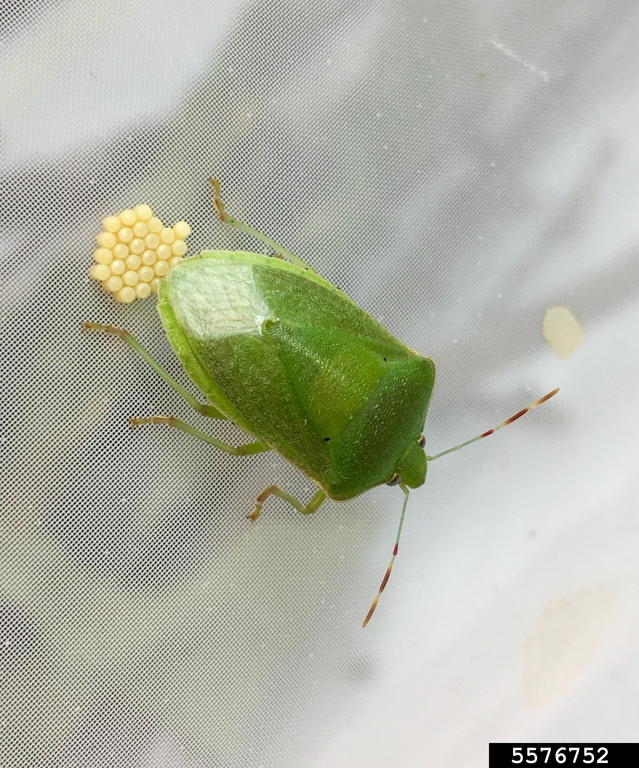
Photo by Jennifer Carr (UF/IFAS)
Adult southern green stink bugs can be identified by the small black dots that line the sides of their abdomens. To distinguish N. viridula from the green stink bug Chinavia halaris (Say), the observer should locate the stink gland pore on the sternum between the second and third legs. This pore will be short and wide in the southern green stink bug but long and curved in the green stink bug.
Biological control of N. viridula is typically facilitated by insects in the orders Diptera and Hymenoptera. In the state of Florida, the tachinid fly Trichopoda pennipes parasitizes adult and nymph southern green stink bugs. The wasp Trissolcus basalis may parasitize the eggs of the southern green stink bug, thereby suppressing populations.
For more information, see UF/IFAS Featured Creatures: http://entnemdept.ufl.edu/creatures/veg/bean/southern_green_stink_bug.htm
Euschistus species
In North America, there are at least 20 species of stink bugs in the genus Euschistus. These stink bugs may be found on hemp, and the brown stink bug, Euschistus servus (Say), has been confirmed on hemp. All stink bugs in the genus Euschistusare predominantly brown and drab in color, but specific variations in their markings and morphology set them apart as different species. All adults of the genus Euschistus have microscopic notches on the anterolateral pronotal margins, and the humeral angles of the pronotum are acute to rounded.
E. servus (Say), the brown stink bug, is considered a very serious pest of a variety of crops in the southern United States. Its distribution in North America extends as far north as southern Canada. There are two subspecies that occur in North America: E. s. servus (Say) and E. s. eushistoides (Voltenhoven). E. s. servus has a distribution throughout the southern United States from Florida to California, and E. s. euschistoides is distributed throughout Canada and the northern United States.
The eggs of the brown stink bug are translucent and yellow, but turn light pink prior to hatching. Nymphs undergo five instars and change from brown in color to light green. Adults are a drab, gray-brown color with darkly colored markings on their backs. The genae, or cheeks, are large and pointed, and they extend past the clypeus.
Brown stink bugs are associated with the flowers and seeds of the hemp plant, and they feed using their piercing-sucking mouthparts. Parasitoid flies in the order Diptera may oviposit into the eggs of the brown stink bug. Two of these parasitoid species include Gymnosoma fuliginosa (Robineau-Desvoidy) and Cylindromyia binotata (Bigot). The wasp species Telenomus podisi (Ashmead) also parasitizes eggs of the brown stink bug.
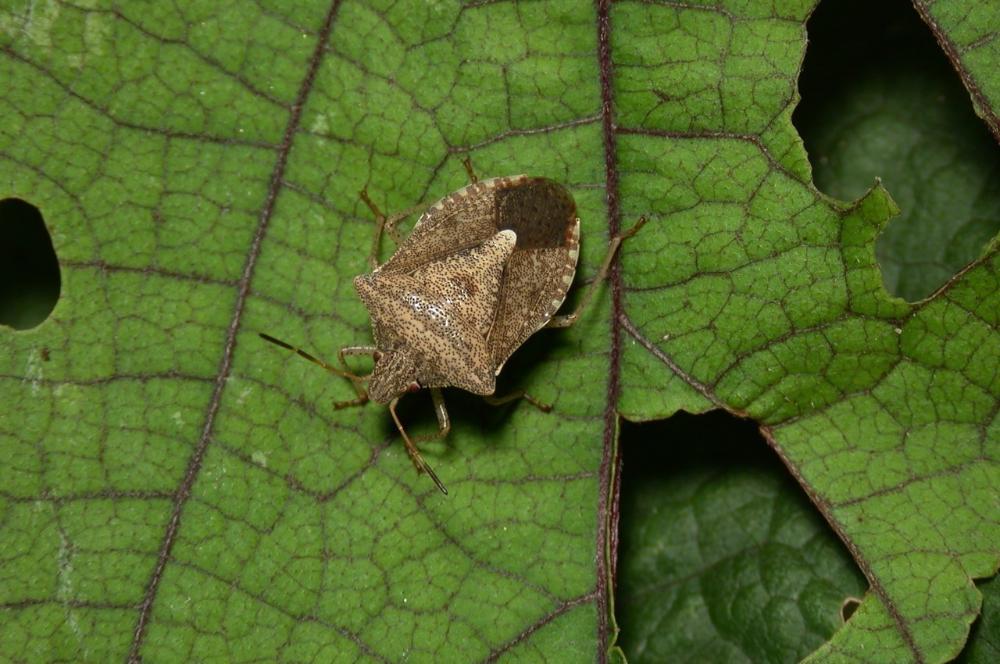
Photo by Lyle Buss (UF/IFAS)
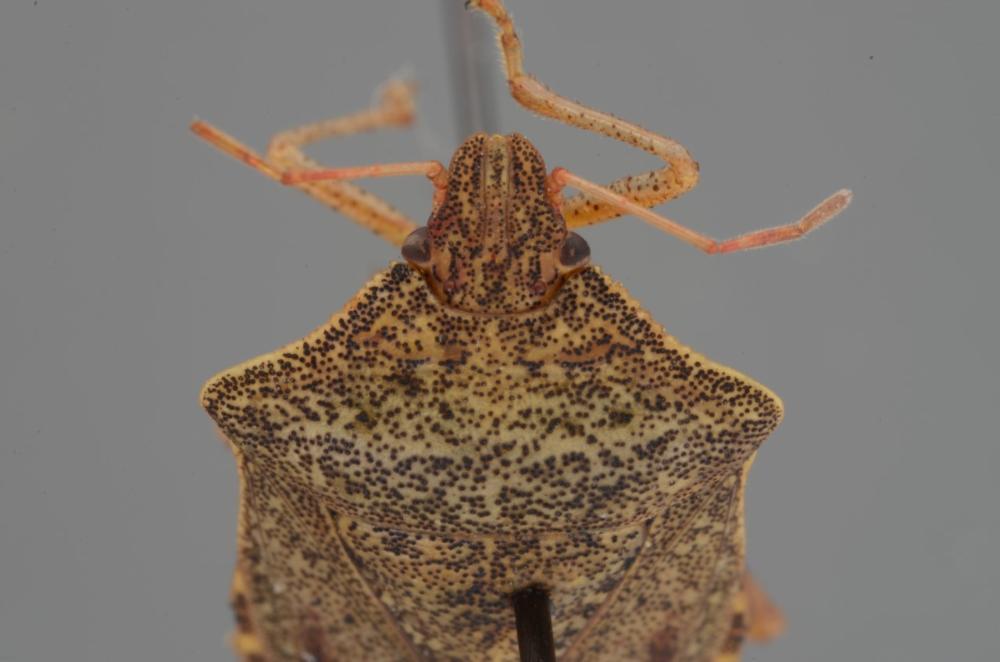
Close up of denticles on pronotum. Photo by Lyle Buss (UF/IFAS)
For more information, see UF/IFAS Featured Creatures: http://entnemdept.ufl.edu/creatures/veg/bean/brown_stink_bug.htm
This page was created by Sarah Birkmire, Graduate Assistant, Entomology and Nematology Department, University of Florida, IFAS (sbirkmire@ufl.edu).
Selected References
-
LYGUS BUGS
Lygus Bugs
Insects of the genus Lygus may also cause damage to hemp plants. Like stink bugs, Lygus bugs are in the order Hemiptera, but they belong to a different family: Miridae. Damage to hemp plants by Lygus bugs is minimal, but they can reduce the quality and production of hemp seeds. They feed using their piercing-sucking mouthparts and tend to target younger plant tissues (including seeds). This feeding may result in seed deformity.
Several species of Lygus bugs have been reported on hemp. Lygus lineolaris (Palisot de Beauvois), also known as the tarnished plant bug, is the most widely distributed Lygus species in the United States. Eggs of the tarnished plant bug are small but elongate. They are often laid singly but occasionally occur in groups. Tarnished plant bug nymphs undergo five instars and are yellow-green in color. As they develop, yellow, green, or black spots begin to appear on their bodies. Nymphs in the fourth and fifth instars have four black spots on the thorax and one black spot on the abdomen. Adult tarnished stink bugs come in various colors, including yellow with black markings and black with yellow markings. They have long legs and antennae and have yellow pubescence on their reddish-brown hemelytra (anterior wings).
There are several species of parasitoids that target both the eggs and nymphs of the tarnished plant bug. Anaphis iole (Girault) is a tiny wasp that parasitizes the eggs of the tarnished plant bug. Several species of Hymenoptera are known to parasitize nymphs of the tarnished plant bug. These include Eristenus pseudopallipes (Loan), Peristenus pallipes (Curtis), Peristenus digoneutis (Loan), and Leiophron uniformis (Gahan).
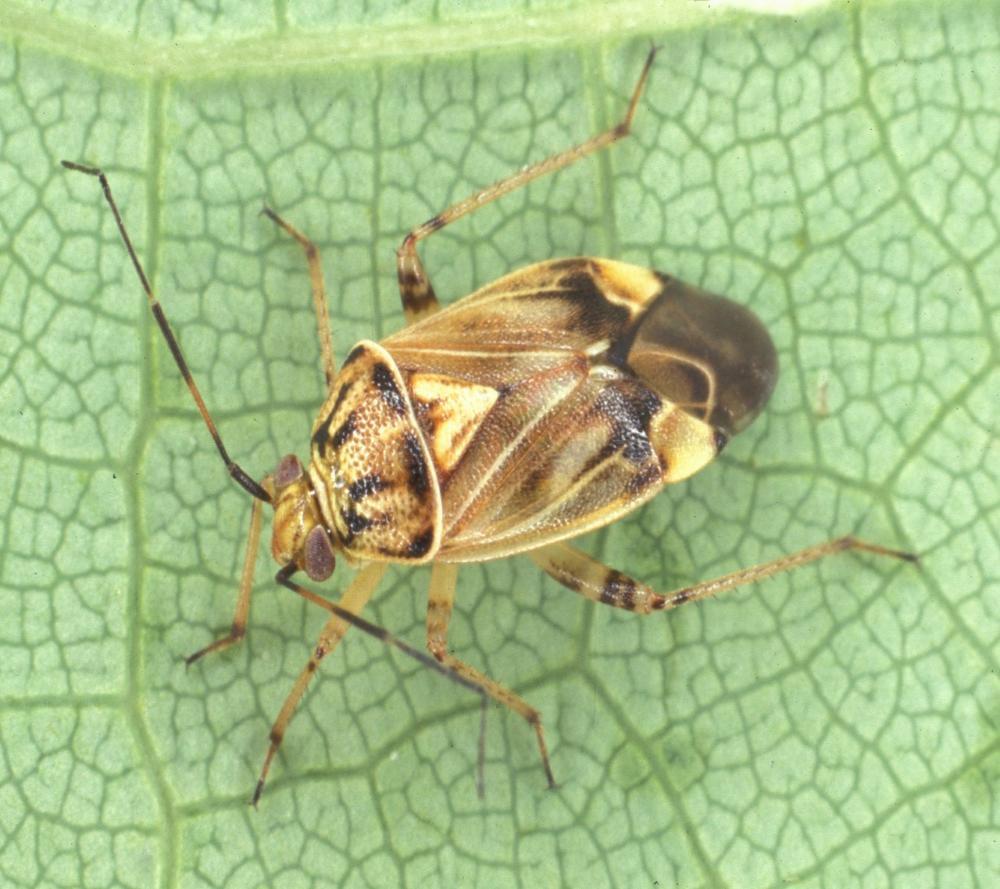
Tarnished Plant Bug. Photo by James Castner (UF/IFAS)
For more information, see UF/IFAS Featured Creatures: http://entnemdept.ufl.edu/creatures/trees/tarnished_plant_bug.htm
This page was created by Sarah Birkmire, Graduate Assistant, Entomology and Nematology Department, University of Florida, IFAS (sbirkmire@ufl.edu).
-
FIRE ANTS
FIRE ANTS
Fire ants (red imported fire ant, Solenopsis invicta Buren, and black imported fire ant, Solenopsis richteri Forel) are omnivorous and can eat the stem of hemp plants, causing wilting and plant collapse. They form single- and multi-queen colonies in large mounds of dirt, rotting logs, around trees, and under pavement and buildings. The queens must be killed to eliminate a colony. Individual mounds may be treated to reduce impacts to native ants. Scalding hot water (190-2120F) poured on the mounds has an elimination success rate of 20-60% and must be repeated. Extinguish Professional Fire Ant Bait is labeled for hemp in Florida, but other chemical baits not labelled for hemp must be placed outside of the production area.

Fire ant damage to roots and crown of hemp plant. Photo by De Broughton (UF/IFAS)

Fire ant tunnelling in crown and root damage on hemp. Photo by De Broughton (UF/IFAS)

Fire ant holes in hemp stem. Photo by De Broughton (UF/IFAS)
For more information, see UF/IFAS: https://edis.ifas.ufl.edu/topic_fire_ants, http://entnemdept.ufl.edu/creatures/urban/ants/red_imported_fire_ant.htm
-
OTHER PESTS
GRASSHOPPERS
American grasshoppers are the main species of grasshoppers seen attacking hemp in Florida. Adults may roost in nearby trees at night and attack daily. Large populations may climb up walls and screen enclosures. Nymphs are short-winged, less mobile, and stay in sunny fields, and the eggs are laid in the soil. The nymphs hatch and remain in small groups but spread out as they mature. Adults overwinter and are present throughout the year while principal hatching periods are from February to May and again from August to September.
Grasshoppers chew on leaves and stems and can eat plants to the ground. Control is through feeding birds (cattle egrets, robins, mockingbirds, and crows), some bee and fly larvae, and insect pathogenic fungi.
The American grasshopper, Schistocerca americana (Drury)
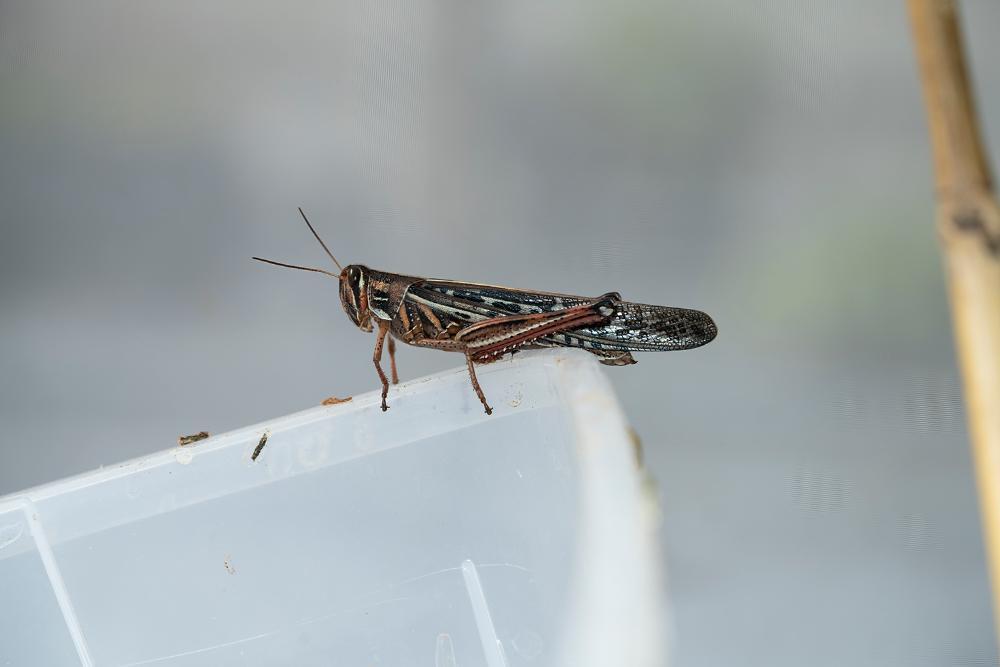
This grasshopper species occasionally causes serious damage to crops and ornamental plants, but their importance as a pest of hemp is currently unknown. The adult shown in this photo was collected from hemp in the field and reared in a greenhouse cage on corn, beans and hemp.
For more information, see UF/IFAS Featured Creatures: http://entnemdept.ufl.edu/creatures/field/american_grasshopper.htm
Eastern lubber grasshopper, Romalea microptera (Palisot de Beauvois)
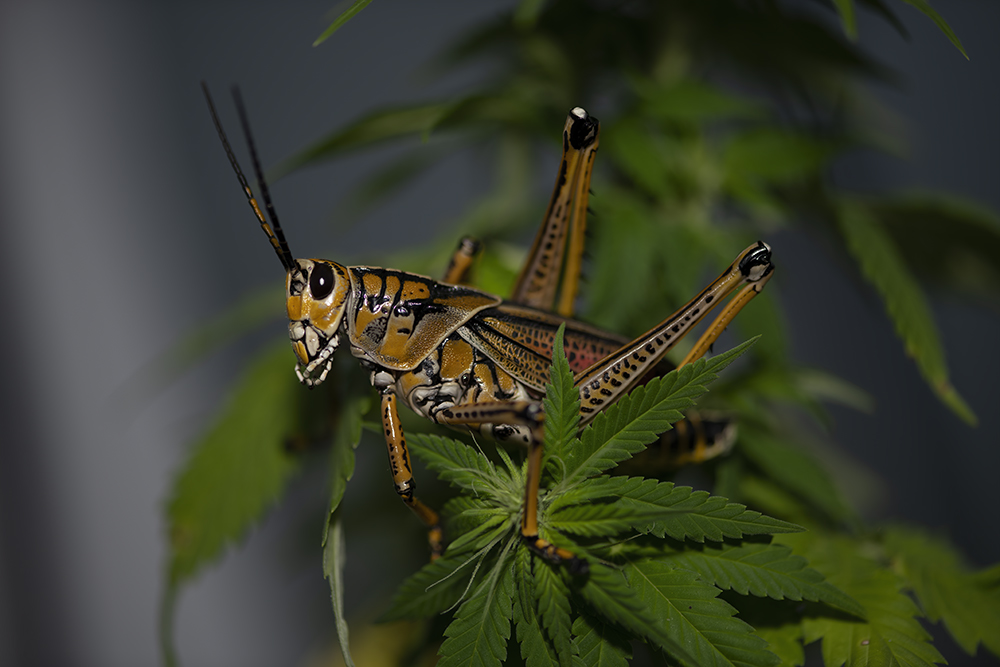
This speices is a common pest of many plants in Central Florida, but their importance as a pest of hemp is currently unknown.
For more information, see UF/IFAS Featured Creatures: http://entnemdept.ufl.edu/creatures/orn/lubber.htm
Acknowledgments
Many people have worked on this website and we really appreciate all of their technical help with both content and web design. I would especially like to thank the taxonomists at FDACS-DPI. The scientists at DPI are world class taxonomists that are critical to the ability of research and extension personnel being able to conduct their work. Dr. Muhammad Z. Ahmed, at USDA-ARS, is the expert on the literature and which pests actually feed on industrial hemp. He has been instrumental in furthering our knowledge of the potential pests of hemp in Florida.
If you have any questions, comments or suggestions please contact either Lance S. Osborne (LSOSBORN@UFL.EDU), Cindy McKenzie (CINDY.MCKENZIE@USDA.GOV), Juanita Popenoe (jpopenoe@ufl.edu), Muhammad Ahmed (Muhammad.Ahmed@usda.gov) or Erich Schoeller (eschoeller@ufl.edu)



